Genus Archachatina Higher classification Archachatina | ||
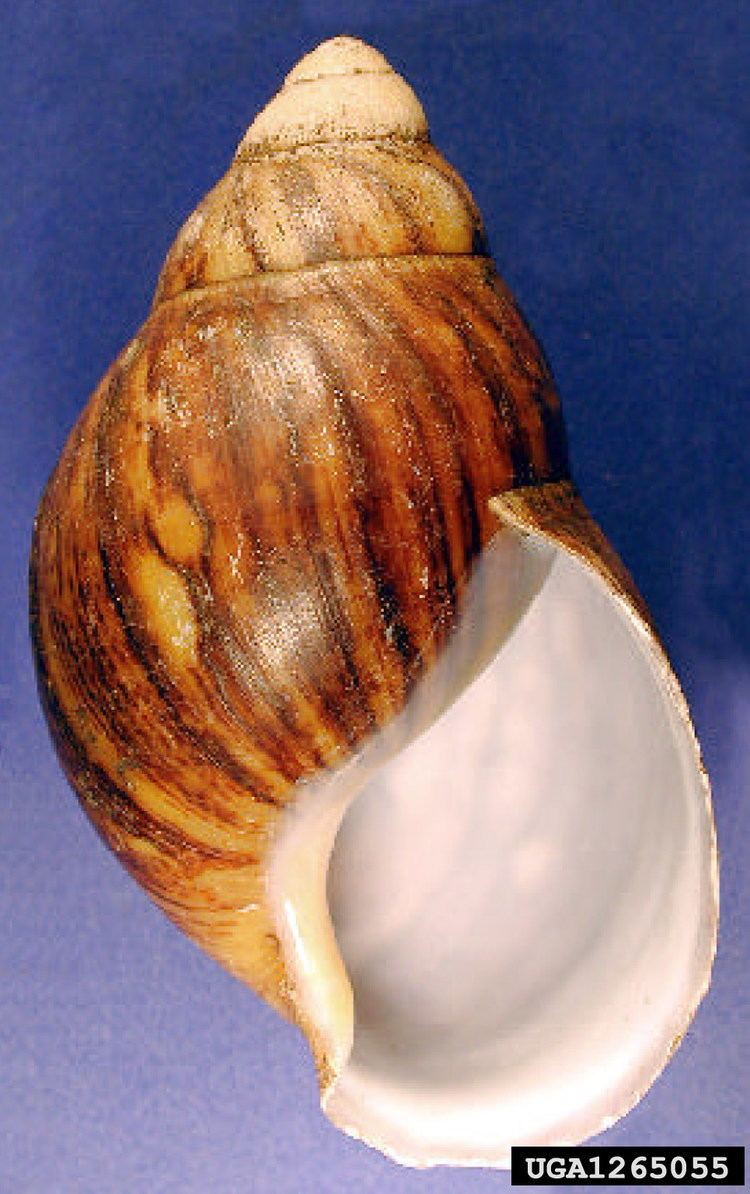 | ||
Similar Archachatina, Achatina achatina, Achatina, Giant African Snail, Achatina reticulata | ||
Archachatina marginata ovum 18cm
Archachatina marginata, common name the giant West African snail or banana rasp snail, is a species of air-breathing tropical land snail, a terrestrial pulmonate gastropod mollusk in the family Achatinidae. They can grow up to 20 cm long, and live up to 10 years.
Contents
- Archachatina marginata ovum 18cm
- African giant snails taking a shower archachatina marginata ovum reuzenslakken
- Distribution
- Description
- Invasive species
- Ecology
- Diet
- Nervous system
- Subspecies
- References
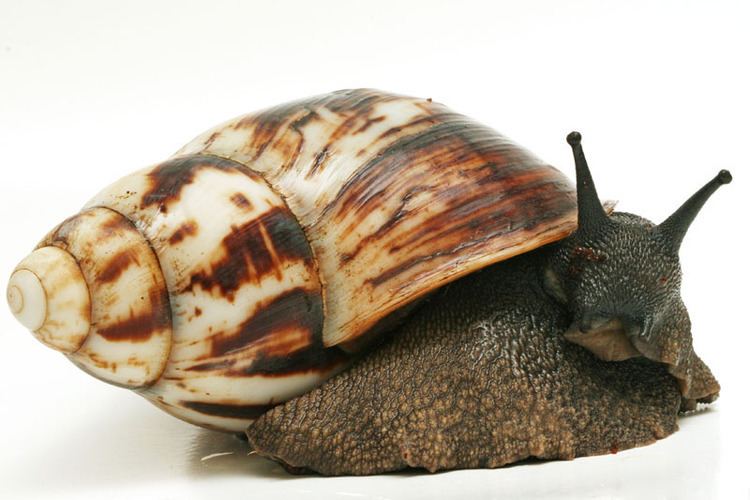
African giant snails taking a shower archachatina marginata ovum reuzenslakken
Distribution
This species occurs in Western Africa: Cameroon through Democratic Republic of the Congo, and can be found in the Caribbean, in Martinique.
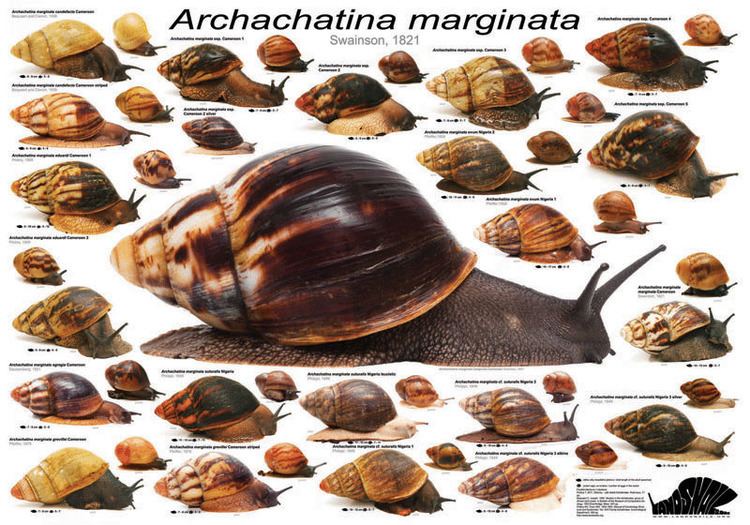
How the species reached Martinique is unknown, but it is possible they were intentionally introduced as "pets" or by workers returning from West Africa.

The natural spread of this species is very slow; however, unintentional spread by individuals for food and as folk medicine is very common. The USDA routinely checks for the species in the luggage of travelers from West Africa, Nigeria particularly, Ghana and Cameroon.
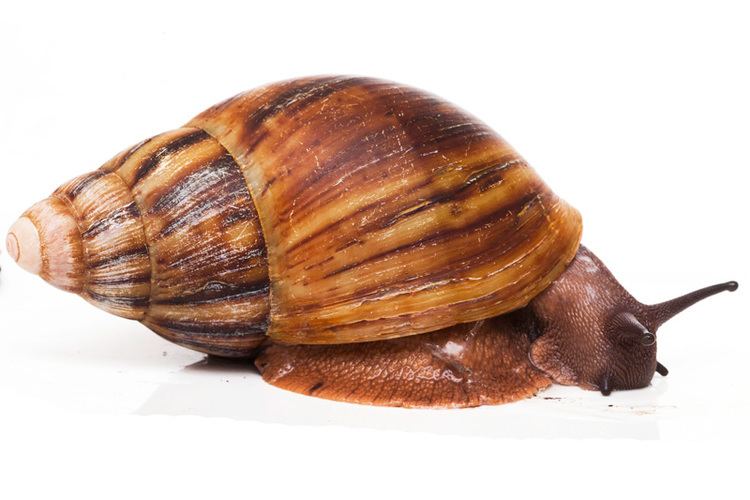
This species has not yet become established in the United States, but it is considered to represent a potentially serious threat as a pest, an invasive species which could negatively affect agriculture, natural ecosystems, human health or commerce. Therefore, it has been suggested that this species be given top national quarantine significance in the United States.
Description
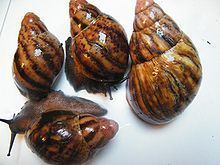
The snail has a bulbous protoconch that is large and broad, with a white or bluish-white columella, parietal wall and outer lip. The shell of the snail can grow up to 21 centimeters in height, and 13 centimeters in diameter. The shell, when magnified, has the appearance of a woven texture.
Invasive species
The snail feeds on a large variety of plants, mainly fruits. Plants included in the snail's diet are bananas, lettuce, peanuts, and peas, some of which are important crops in certain economies. The giant West African snail is one of the worst invasive species in the world and is extremely devastating to any species that it affects. However, the more prevalent problem with the spread of the snail as an invasive species is that it is often a carrier of the parasitic rat lungworm which causes angiostrongyliasis which in turn is the most common cause of the eosinophilic meningitis or eosinophilic meningoencephalitis, which is the public health issue what makes the snails' spread to North America problematic. If the snails continues to spread it could potentially be a problem for the health of people all throughout North America from Cuba to the United States.
Ecology
Achatinids are nocturnal forest dwellers but can adapt to disturbed habitats. The snails prefer concealed habitats and if overcrowding occurs, they may colonize more open habitats. During periods of high humidity, Achatinids are more active but if the individuals are found during broad daylight it is most likely due to high population density.
Eggs of Achatinids are normally laid in the soil, but can be found under leaves or rocks. They produce as many as 40 eggs which are yellow in color with dark blotches and an incubation period of approximately 40 days.
Diet
Wild snails eat plants at a ferocious rate. Oftentimes this leads to property destruction and damage to homes. Studies have shown that the snails will eat during the day but they prefer to eat at night. Wild snails have a very wide appetite on a whole and they are known to eat up to 500 different species of plants. Snails that have become domesticated typically consume food that is high in protein and low in fats. Studies from 2005 that were done to test food on domesticated snails have shown that poultry droppings have been the most effective meal to both grow and gain weight.
Nervous system
In this organism's nervous system, there are two main types of nerves: pallial nerves and visceral nerves. Pallial nerves are the subject of the majority of scientific research. Visceral nerves are split into two subcategories: the main visceral nerve and the rectal visceral nerve. The main visceral nerve is on the snail's back and connects to a large group of nerve cells to transmit information in the body. The rectal visceral nerve starts further down under the main visceral and extends a short length before branching off near the rectum.
Heat can stimulate reactions in the West African snail as a result of the snail's nervous system. The nerves produce warm responsive fibers when the temperature exceeds 25 °C and produce cold responsive fibers when the temperature falls below 19 °C. The ideal temperature range for this species falls between 13° and 32 °C; this is also formally known as the thermopreferendum of the species.
